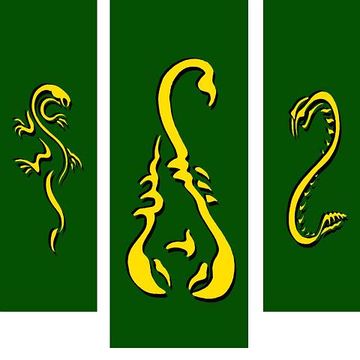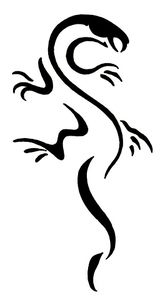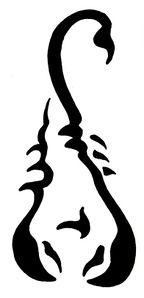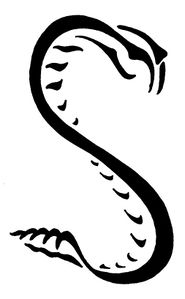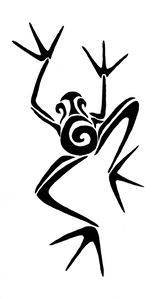Druj
Overview
No other orc tribe is as ruthlessly dedicated to survival as the Druj. When defeated they always come back stronger and craftier, learning from each failure. Driven by the desire to avoid the Howling Abyss, they push themselves to the limits seeking ever more cunning exploits to prove their worth to their ancestors.
From a young age the Druj are taught that each living creature is defined by its weaknesses. The successful guard their weaknesses well, and exploit those of others. Those who show weakness are merely there to be manipulated, and will fall to the Howling Abyss, never to speak to their descendants or aid their tribe from beyond. One of the most potent weaknesses is fear, and the Druj are past masters of making it their servant, using it as a weapon against their enemies. As long as it benefits the tribe in the long term, the Druj will use any underhanded tactic in pursuit of success; poison, ambushes and dark magic are all part of their repertoire.
Druj seek to inspire such dread in their enemies that they will have won the battle before they even come to fight. The weak will bow before them, while the strong will seek easier prey elsewhere. Their society is tiered on perceived weakness; powerful clans expect deference from their lessers, who in turn do their best to twist and manipulate those slaves, servants and allies beneath them. A vast and terrible web of fear and cruelty extends about the Druj lands. The Druj regard a battle as being like a hunt: The objective is to get the enemy panicked and tiring themselves out so that they are easily separated and picked off. They like to inflict injuries that will slow the enemy down and saddle them with wounded and poisoned. They make extensive use of lures and ambushes, and consequently they much prefer fighting in terrain with good cover, and typically have hidden units ready to strike at vulnerable flanks and then melt away again. They don't want to get sucked into mass stand-up fights if possible, but they excel at skirmishing.
It is said that the Druj have a saying "You cannot betray your enemies" (which the Navarr stole from them). It is well known among the other major orc tribes that an alliance with the Druj will last only until it benefits the Druj more to betray them than to keep the alliance. Deals with the Druj often become a cat-and-mouse game to see who breaks their agreement first. This applies only to their fellow orcs; when it comes to Imperial citizens, any offer a Druj makes is almost certainly a trap. Many Imperials have met a tragic end because they either assumed that this time the Druj were not tricking them, or because they assumed they saw the trap ... missing the other traps nested within.
The Druj are led by chieftains known as Het, each of whom commands several large extended families collectively referred to as a clan. Clan leadership is achieved through successful raiding, and demonstrations of skill, cunning or willpower. A prospective Het must also pass a series of grueling tests administered by the shamans, such as seizing hot coals without flinching, devouring live poisonous beast, reciting family history and exploits without pause or error while simultaneously defending themselves from arrows, or sneak through enemy territory and kill a single specific opponent and then escape.
Each clan has a single poisonous beast or plant as it’s totem, and will also typically have an adjective on the clan name. For instance Creeping Nightshade, Bone Scorpion and Black Hydra are all large and powerful clans, each with their own special area of expertise.
The Tribe
The Druj hold many smaller tribes by the neck, sending them into battle ahead of their own forces. The Druj are viewed with dread by these tribes, ever fearful of displeasing their masters and the ruthless cruelty that will descend should they betray their masters. Despite this, they can express unpredictable levels of magnanimity, rewarding members of smaller tribes who serve them well, or succeed in particular gruelling missions. Their very unpredictability helps to maintain their position of power. Many Imperial soldiers who think they have fought the Druj have actually fought members of a subject tribe, perhaps supported by a few small units of Druj warriors who seek to exploit the chaos of the battlefield to strike at their opponents before withdrawing.
More than any other tribe. the Druj make use of herbs and potions. The apothecaries of the Druj are respected for their ability to poison enemies and heal allies. They equip their warriors and magicians alike with preparations that allow them to replenish their resources, and are constantly seeking new ways to employ their herbal lore. Some escaped Druj slaves speak of being used as experimental subjects by the twisted druj herbalists who test poisons, antitodes and narcotics on them.
Compared to the Jotun and the Thule, the Druj have few artisans, preferring to reinforce their troops with potions. The best enchanted items are invariably claimed by the Het and the Ghulai.
Warriors of the Druj
The bulk of most Druj armies comprised of various subject tribes that send warriors to fight from all across the Mallum. Many of these warriors are forced into service, through threats or violence; whilst others volunteer to fight, perhaps hoping for a swift death by Imperial sword or by displaying their usefulness to their masters in battle. The rank and file of the Druj armies are hardly a spectacle to behold, poorly equipped unlike a Grendel mercenary, and ill-motivated unlike those in service to the Jotun. A subject warrior counts themselves lucky to have a crude breastplate to wear over their ragged clothes and a longsword in their hand. The commanders, or Het, of the Druj forces do so through intimidation and cruelty, choosing to send their underlings ahead of them in an attack and always keeping a close eye out for danger. This can make the forces of the Mallum a dire and savage foe to face, as the orcs strive to overcome their enemy as swiftly as possible before superior tactics and arms can be turned against them.
The elite troops in the Druj's forces are the Arkad, crafty warriors who follow ancient methods of war based upon aspects of dangerous animals held to be important in Druj culture. These warriors seek to engage the Empire to display the mastery they have of different ways of war, to sow terror and bleed their foes. There are four main groupings of the Arkad that can be found in most Druj forces. They are often accompanied by the apothecary physicians known as the Tepel, skilled potion brewers and masters of poison.
- Armies of Druj are often supported by one or two swamp- or forest-dwelling beasts, especially catoblepas and marshwalkers. These creatures are often deployed to spread chaos and fear, and when supported by other Druj warriors are often used to break defended positions.
The most well-known quality of the Druj is their use of poison and infection. They make extensive use of a herbal preparation they call swamp fever, but some warriors favour a blade venom they refer to as sweetblood. Many Imperial citizens have heard tales of Druj force-feeding fallen warriors - especially fallen healers or recognisable heroes - horrible preparations that cause them to die in agony to demoralise their opponents.
Armies fighting Druj should be prepared to find their wounds poisoned, festering or becoming infected; even Druj subject tribes routinely smear their weapons in filth and excrement.
Magic
Druj magicians are trained in combat magic to fight alongside the warriors. They are especially proficient at spells that poison or weaken their foes. Druj rituals often involve venomous plants and animals. Commonly these are handled or consumed during rituals, allowing them to poison the ritualists multiple times.
Only magicians that have proven themselves in battle are inducted into the Ghulai caste and taught the secrets of the tribe’s rituals. Some shamans with connections to Ghulai ancestors side-step the initiation, serving instead as apprentices to more experienced Ghulai from their family. Thanks to natural attrition the Ghulai are comparatively rare, but tend to be individually powerful. Secretive and sinister, even the Het tread lightly when asking for their aid, as it often comes at a high price. Ghulai are are commonly accompanied by several apprentices for protection and menial labour. They also employ a form of bone-casting using etched human skulls as an aid to scrying rituals - preferably the skulls of enemy magicians and a Druj seen bearing many human skulls is usually a waning that a potent Ghulai has taken the battlefield.
The Ghulai make extensive use of Spring rituals, and are known to enjoy the effect that Fetid Breath of Teeming Plague has on enemy soldiers. They are also known to favour Night magic that conceals or misdirects, although the Ghulai pride themselves on evoking these kinds of rituals in subtle ways - for example, a Druj magician will often use an obscuring ritual to misdirect Imperial diviners as part of a feint.
Powerful Ghulai seem to be responsible for creating horrific totem mounds for the Druj; these blasphemous shrines are built from the desecrated remains of enemies of the Druj and are found throughout their territory. They are enchanted through poorly understood means to create oppressive miasma of fear and dread. The older these totem-mounds are, the larger the area they cover. Once the aura is established, merely destroying the totem mound simply causes it to begin decaying - Imperial priests work alongside armies to track down and swiftly cleanse these spiritually corrupt areas. Lesser effects have also been reported as connected to Druj battle-standards, and there is a great deal of debate among theologians and academics who study the Druj as to whether these are truly ritual enchantments or whether Druj shaman are using abilities similar to consecration and hallow, possibly empowered by some hitherto-unknown herbal preparation. No compelling evidence of the latter has been uncovered, and while some Druj prisoners have hinted that this is the case all Imperial scholars know that the Druj lie.
The Imperial Orcs
TBC
History
TBC
Look and Feel
On the battlefield the Druj strive to project a terrifying image. They usually wear dark colours, suitable for hiding in bogs and swamps, often with hints of dark green and yellow. Their gear is often designed to strike terror into the hearts of the enemy, but they will rarely encumber themselves with anything that would make fleeing impractical. Bones and skulls (especially the latter impaled on spikes or staves), body parts, leather made from human or orc hide, vicious and intimidating runes, armour spikes ... all of these are common Druj decorations.
Druj are very fond of weapons that keep their enemies at bay; spears, thrown weapons and bows are especially favoured. Warriors who must fight in close combat favour pole-arms over one- or two-handed weapons.
Playing the Druj
The Druj are cruel and without mercy. They much prefer short, skirmishing engagements followed by a retreat to a more defensible location. They like to spread chaos and fear, and their tactics are often characterised by the idea of a 'burst of violence'. Druj aren't stupid, they only fight when cornered or at an advantage. Typically a close skirmish unit returns to the shamans for restoration, or retreats once their resources are depleted, and hence they are rarely afraid to unleash all their special powers to overwhelm an opposing force with 'shock and awe' tactics. While the normal rules about executing fallen opponents apply, a Druj warrior who ends a battle with a cleaving blow will cheerfully use it on a fallen opponent before retreating.
Like all good hunters, the Druj carefully study their prey, and do their best to provide themselves with appealing bait. Against Imperials they have found that artefacts of faith or Imperial history or national culture often generate a disproportionate level of emotional response - something they find quite delightful for luring the headstrong humans into traps.
